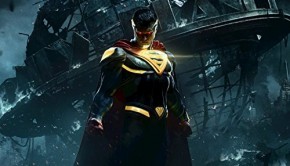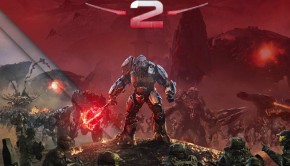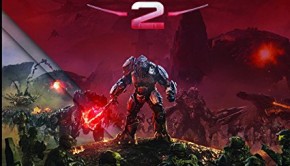Pierre Langer Interview: The Principles of Dynamedion
 Dynamedion is the leading studio for soundtrack composition and sound design in the European video game industry. The company has pioneered orchestral recordings in game music with major scores to the SpellForce and Anno series. Having featured on nearly 200 projects to date, the company has branched out to encompass sound production for television, film, and mobile games too.
Dynamedion is the leading studio for soundtrack composition and sound design in the European video game industry. The company has pioneered orchestral recordings in game music with major scores to the SpellForce and Anno series. Having featured on nearly 200 projects to date, the company has branched out to encompass sound production for television, film, and mobile games too.
In the first of a multi-instalment interview with its team, Dynamedion’s co-founder and managing director Pierre Langer introduces readers to the company. He details the principles, methodology, and scope of the company — highlighting a number of ways their music and sound production techniques are unique and innovative — before giving an insight into their recent developments, including their open orchestral recording sessions and their upcoming soundtrack store. This compelling interview offers particular insight into the organisational and business side of game audio production.
Interview Credits
Interview Subject: Pierre Langer
Interviewer: Chris Greening
Editor: Chris Greening
Coordination: Chris Greening
Interview Content
Chris: Pierre Langer, thank you for speaking to us today. First of all, could you introduce Dynamedion to our readers? Could you tell us about the concept and history of the company?
Pierre Langer: When Tilman Sillescu and I started the company in 2001 I was just finishing my music studies at university. We were both working as lectures for Modern Media at our university, teaching younger students how to work with sequencers, make good recordings, etc. During that time we really didn’t think a lot about how to raise an audio company; we simply had the luck to get a chance to write some music for a small game. I was some sort of jack of all trades, doing composition, sound design, audio integration and the business side of things, whereas Tilman was really the creative director — writing music in a lot of different styles, being the real expert for everything related to music.
It was only a few years later, after having done our first major projects in the German games industry that we thought of hiring additional talent to write music for us. The idea was pretty simple: we started to build a team of freelancers, all working from their own locations, with their own studio and equipment. We built the intelligence and infra-structure to work remotely with a high efficiency, doing the “lead” work like project management, business development and creative direction from our headquarters. Today with over 20 people working for Dynamedion, the structure is still the same. We only have four people in house, all the other guys are working as freelancers. In a way we are more of a network of audio people rather than a full company. However we keep on working with the same people and we do not bring in additional talent any more, as we feel that our team is really in perfect shape at the moment.

Chris: Dynamedion has become the leader in soundtrack composition and sound design in the German game industry. While many know Germany as the centre of many Amiga and Commodore 64 productions, what is its game industry like today? Are there many major developers?
Pierre Langer: Things have certainly changed a lot. There are only a few major players for high-end console or PC games today in Germany, like Crytek, Yager, Related Designs or Bluebyte. However Germany is a big market, so there are a lot of game developers doing mid size or smaller productions. In addition to that Germany has become the leader for Free to Play Online Gaming. Publishers like GameForge or Bigpoint are the biggest players in the world and they are doing a lot of projects rights now. Of course we do not limit ourselves to the German market. We have done major projects in France, Scandinavia, Korea, Taiwan, the Eastern European market and of course the US, not only in the games business but also in the TV, movie and trailer industry.
Chris: In 2005, your team produced the first live orchestral soundtrack recordings for a German game soundtrack with SpellForce 2: Shadow Wars and The Guild 2. Could you share your experiences from such recordings? What did an orchestra offer to these scores that their predecessors lacked?
Pierre Langer: Right from the beginning we felt that live orchestra recordings are very important for this new industry. As Tilman and I both studied classical music it was pretty clear that we had to move into that direction as soon as possible. Germany has the highest “density” of professional live orchestras in the world. It is sort of built in the bones of the country that the government and the states keep a lot of big ensembles in place. So we had everything on place — we just had to find a developer willing to pay for the additional costs.
I think that SpellForce 2: Shadow Wars certainly was an iconic and pretty unusual soundtrack in some ways. If you listen to it, you will find tracks that are very long and have something symphonic, European I’d say, just enough time to breathe and to develop. This was just perfect for the orchestra, as the players could really bring in all their experience they have with classical music. To have 70 players interpret your music is just something magical. Every single player starts to put some emotion into music that was played by a digital sequencer before. The result is really just amazing: all of a sudden the music comes to live, with so many subtle movements and little variations. A lot of it strikes the listener on a very subconscious level: you feel rather than notice that this is alive. Given the context of a “digital game world” that is not alive at all, this makes a huge difference in the emotional perception of a game.
This is something that a lot of producers of games still do not really understand: it is not about people being able to directly tell the difference between live and virtual music. It is about what is going on with the player emotionally, what kind of feeling the music creates.
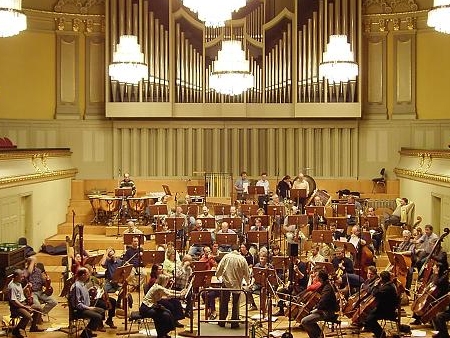
Chris: Nevertheless, you team has also written some major symphonic scores without using orchestras, such as the recent Drakensang titles. How do you create the symphonic sound without the budget for full orchestral recordings? To what extent are your sound designers — and indeed sound designers in general — able to emulate an orchestra?
Pierre Langer: There are two sides to our music work. We definitely always improve our skills with virtual orchestra setups — always striving to sound as close as possible to the real thing. On the other hand, specifically with certain music styles, a live orchestra simply can’t be matched by a virtual mockup.
Given the fact that a lot of projects do not have the budget to pay for a live orchestra, we are indeed doing a lot of virtual orchestra music. The composers who are writing orchestral music in our team are all real experts when it comes to emulating this kind of ensemble. They are constantly sharing their methods of working and doing a lot research on new instrument libraries, etc. This is a great advantage for our team, as every writer has some special abilities that others do not have. Sharing these really boosts the performance of each writer. However this kind of ability is a skill of its own. There are a lot of great composers out there who are not very good at making great virtual orchestra mockups. They have to rely either on people mounting the synthetic versions for them, or using live players. At Dynamedion it is compulsory to be very good at virtual mockups.
Concerning the question of how close you can get to the real thing: it is possible to make mockups that are so good that your average listener can’t tell the difference. But this doesn’t work for all styles and the virtual music always lacks this subconsciously emotional touch. So if we write an orchestral soundtrack without having a live orchestra, we definitely choose the right style and see to it that we add as many single live instruments as possible.
Chris: In particular, could you elaborate on your Music Mixed Mode production technique?
Pierre Langer: I was just coming to that actually. The Mixed Mode Music is something very important at Dynamedion. It is pretty simple: we always add live instruments to any kind of production that needs the live touch. All our writers are able to play numerous instruments, and they keep on learning new ones all the time. Of course we also bring in a lot of additional musicians if needed, but it is amazing what can be done by every writer directly. Tilman, as a studied guitar player, for example can play all sorts of guitar-like instruments; in addition to that we studied the clarinet and saxophone for a few years and he plays all sorts of flutes and percussions of course. As a lot of the music needed for media is not too sophisticated you do not always a super professional musician just to play some easy melodies. It is about the human touch that we add with all the recordings we do.
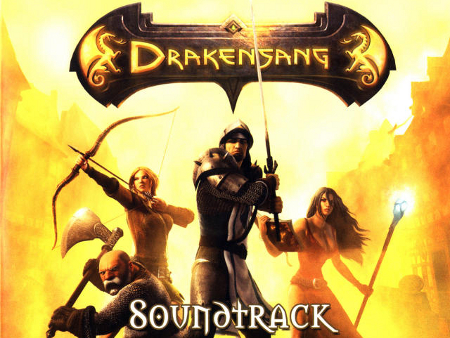
Chris: Furthermore, Dynamedion is known for working on games for a variety of technologically limited devices, such as the DS or mobile phone. How do you accommodate these limitations during the scoring and sound design process? Is it conventional for you to create non-symphonic music for these smaller titles?
Pierre Langer: The specific formats for Nintendo DS or MIDI stuff for mobile applications are something completely different. This is very close to the way of working on the Commodore 64 or the Amiga. We have two writers who are focusing on this type of production — people who have worked as composers during the Commodore era already. This is actually the only thing I never did myself; I simply can’t figure how to get an adequate sound out of 100Kb of storage.
Chris: Dynamedion’s model differs from many music production companies, in that its associate musicians are freelancers rather than in-house employees. What inspired this approach and how is it advantageous compared to other models?
Pierre Langer: Well, we got inspired by the model that Hans Zimmer did in Hollywood with Media Ventures at the time. Composers are really used to working as freelancers: they like to keep their freedom, they usually have very individual ideas of how they want to work and they all have their own equipment anyway. So in a way I think it is a pretty straightforward approach to build a network rather than a 9 to 5 working environment. The tough thing to achieve is to get this team to work as if it was an in-house team. In my opinion this is one of our major achievements: to our clients it seems as if all the work is done in-house, even to a point where people are asking “How can Tilman possibly write all this music?”. Even though we always give full credits to our writers of course, this question shows that our clients really do not even notice that we have various writers working on one project.
Chris: On major projects such as BattleForge and Halo Legends, it is common for the composers of Dynamedion to collaborate. How do you coordinate music production for such titles? What advantages does teamwork bring?
Pierre Langer: This is something that is closely linked to the last point. All the writers are used to working with other writers at Dynamedion. We usually do not put more than three writers on one project. One of them gets some sort of “lead” job — for example if this writer is the one who wrote the main theme, or won the pitch with his composition. Every project as a micro hierarchy that way: one writer leads the way, sets the style and sound, and the other write additional content using this setting.

Over time some clients develop a certain affinity to special writers. We like this a lot as the client gets a very individual service that way while keeping more than only one writer on the project. The advantage is of course that every writer is a bit different. This adds to the musical color and variety of a soundtrack. The important thing though is to make sure that the soundtrack is still one big entity, with one style and attitude. Our writers are all very open minded to outside influences, which also makes it very easy for us to collaborate with writers that are not in our team. This happens a lot in big productions: the developer does not only hire one audio team, but several vendors. For us it is no difference as we are working that way all the time anyway.
Chris: As the co-founder and managing director of Dynamedion, readers would be interested to learn more about your own background. Are you able to tell us more about yourself? Do you still receive the opportunity to compose sometimes these days?
Pierre Langer: Well, I think a lot of it has already been said. I started playing the guitar at the age of 9, did a lot of band projects during my teenage days, and then finally I ended up studying classical music and took my degree in 2001. I always had a very strong interest in business things, being the guy organizing everything with my bands by the time. After Dynamedion continued to grow with the years I had to concentrate on the business side more and more. Bit by bit I quit all the audio work: first I didn’t do the audio integration any more, then I stopped doing sound design, then I stopped doing virtual mockup compositions, and finally I even gave up writing for live orchestras. The other guys where simply getting so good at it that I couldn’t keep up.
Although I was a bit sad when I stopped writing a few years ago, I feel great about it now. My background gives me a very deep knowledge and that makes it much easier for me to “sell our products”: music, sound effects and audio management. I did it all, at least for some time, and even if all the guys at Dynamedion have outranked my skills by far in the meantime, every client notices that I really know what I am talking about, when discussing a new project.
Chris: In addition to contributing to specific game scores, you and other artists have contributed to various music production libraries. What do your team offer in this role? Could you discuss how your libraries have been used for various movie trailers, commercials, and other media?
Pierre Langer: The production music libraries, as well as the work for hire jobs we are doing for TV and all other media, is just another branch of our service. Music really is something that a lot of people need. We love to work for the games industry and we will keep this our major market, but it is good to work in other industries as well. This makes the business more stable and of course it is fun to have variety.
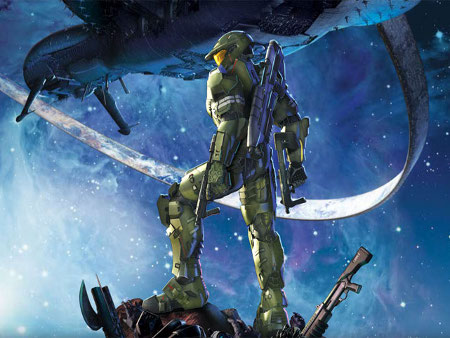
When it comes to production music in libraries, we have no say in how the music will be used. The library publishers are the ones doing the business for us, we simply deliver the music. It is always interesting to check the music statements and see how the music has been used. We have several thousands of tracks in various libraries in the meantime, so we are getting some serious usages and great credits now.
Then of course there is the work for hire side for TV. Our main market is the US for this kind of work. We have a great agent in New York and another one in LA. They are bringing in theme packages for TV shows, promos and ads and we are happy to work on those.
Chris: Recently, you have developed a new service of open recording sessions for interested clients. Could you discuss and what clients you expect to work with?
Pierre Langer: The idea came up during the recording sessions we did for bigger projects. We always had a few minutes of recording time left that we usually filled with our own music for other projects. At a certain point we realized that the possibility to record only smaller bits of music with a big ensemble might be pretty appealing to other people. It is a terrible strain to organize a live orchestra session and you can’t book an orchestra for only a few minutes worth of music without paying a lot of money, as the whole setup is costly and you always have to book an orchestra for at least half a day. After having done more than 20 big live orchestra recordings, our process of organizing such sessions is very streamlined.
In 2008 we started recording single tracks for games during sessions we did for our own projects anyway. For example we recorded a main theme that had been written by a composers outside Dynamedion in order to pitch the recording as a service itself. The results were just great: we ended up doing the full orchestra recordings for Darksiders: Wrath of War, HALO Legends, and Alan Wake. Our clients simply had the chance to see what our service was like without risking a lot of budget, by recording only one or two tracks during such a “test session”.
In the meantime we brought the service to another level: we are doing regular sessions each three or four months, open for anyone who wants to have something recorded. We are already doing our third open session on May 28th and 29th, doing anything from only 45 seconds for an advertisement to a full 20 minutes EP for some pop music production. Of course this service is still pretty new — so we are constantly looking to build our pool of potential clients. Doing this as a collective thing really brings the price down to amazingly low figures; I do not think that anyone can record only 2 minutes of music in such a high quality for such a low price anywhere in the world right now.
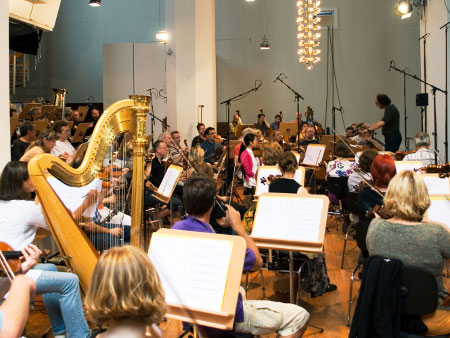
Chris: Finally, it would be interesting to learn about your innovations for the future. Could you discuss what you have planned? In particular, what will you offer on your upcoming soundtrack website? Many thanks for your time to today.
Pierre Langer: There are quite a few things we want to try out in the next time. We definitely had a good start with the open orchestral recording session that I mentioned, but we will not stop right there. Music is something that really keeps its value, if the production quality is good. The next thing we will do is to launch a new website offering our soundtracks (www.sonicsenses.com). On the long run it will not only contain music from games, but all sorts of music we write. TV themes, lounge music, all sorts of styles that we feel people will enjoy listening to. However this is only a smaller project, to keep our music out there and to make our fans happy. We will do some more big things pretty soon, but you should ask Axel Rohrbach, our lead sound designer, about those.
Thanks a lot for your questions — I enjoyed this very much.
Posted on April 28, 2010 by Chris Greening. Last modified on May 21, 2014.

